TT-Magazine Newsletter
To receive email notification of media releases, click the "Subscribe" button and please fill in the form below.
|
2010 August
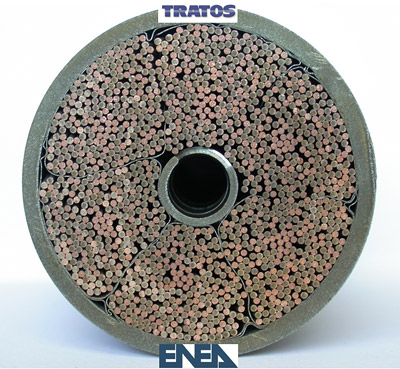 Cable manufacturer TRATOS CAVI Spa of Italy is pleased to announce that, as part of a group tender, it has won a four year contract worth €49 million to supply superconducting wire for the world ITER reactor and the Japanese JT60SA. The superconducting Cable-In-Conduit will be used in the construction of magnets for these projects. Cable manufacturer TRATOS CAVI Spa of Italy is pleased to announce that, as part of a group tender, it has won a four year contract worth €49 million to supply superconducting wire for the world ITER reactor and the Japanese JT60SA. The superconducting Cable-In-Conduit will be used in the construction of magnets for these projects.
ITER is an international project to design and build an experimental fusion reactor based on the "tokamak" concept. The project, which is currently under construction in the South of France, is to demonstrate the feasibility of energy production by controlled thermonuclear fusion.
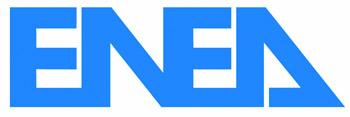
The tender for the production of superconducting wire was put together by the Italian National Agency for New Technologies (ENEA) in conjunction with Tratos and Criotec (a specialist in components operating at extremely low temperatures). The excellent results achieved from the prototypes enabled the group to participate fully in the tendering process on an international stage with high level competitors, eventually leading to the award of the contract.
|
|
Read more...
|
|
 Antonio della Corte Antonio della Corte
The ENEA Superconductivity section plays a very important role in all the experimental campaigns for the characterization of ITER conductors and magnets and for various superconducting/cryogenic components of LHC of CERN , as well as the monitoring of the manufacturing of conductors and magnets carried out by LUVATA (ex Europa Metalli, EM) and ANSALDO Superconductors (AS), which are the two industries in Italy mostly involved for what concerns the production of strands, cables and magnets.
Under our direct supervision, in 1978, EM began the construction of a conductor in NbTi for the first large scale superconducting coil completely designed and realized in Italy by AS. This coil, with a max field of 6T and an inner diameter of 1.3m, was completed in 1980 and installed in the SULTAN experimental facility (Villigen, Switzerland), where it is still operative.
|
|
Read more...
|
 Antonio della Corte Antonio della Corte
The technological research and development activities carried out to validate the International Thermonuclear Reactor (ITER) and demonstrate reactor feasibility cover a wide range of multidisciplinary areas. The work requires considerable extrapolation with respect to the state of the art as well as a lot of systematic integration.
The most important and strategic areas are:
- high heat-flux components (vacuum&surface technologies, plasma-wall interaction),
- advanced materials,
- neutronics,
- remote maintenance (mechanical apparatus),
- fuel cycle (membrane reactor),
- design methods (nuclear and thermo-mechanic),
- electromagnetics,
- analyses on the safety and environmental impact of fusion (fundamental to demonstrating the advantages of fusion to the public).
|
|
Read more...
|
 The International Thermonuclear Experimental Reactor (ITER) project represents the next step in the development of fusion energy. ITER will be the first fusion plant to have almost the same dimensions as a conventional electric power station; the mission of ITER is to demonstrate the scientific and technological feasibility of fusion as an energy source. The detailed design of the reactor has been thoroughly tested on the basis of intense R&D activities carried out by hundreds of researchers and technicians at numerous research centres, universities and industries all over the world. The International Thermonuclear Experimental Reactor (ITER) project represents the next step in the development of fusion energy. ITER will be the first fusion plant to have almost the same dimensions as a conventional electric power station; the mission of ITER is to demonstrate the scientific and technological feasibility of fusion as an energy source. The detailed design of the reactor has been thoroughly tested on the basis of intense R&D activities carried out by hundreds of researchers and technicians at numerous research centres, universities and industries all over the world.
The European Union, Japan, Russian Federation, United States, the People’s Republic of China, the Republic of Korea and India signed officially (at Moscow on 28th June 2005) the agreement to realize ITER. The construction began in 2007 at the European site of Cadarache in the south of France.
|
|
Read more...
|
|
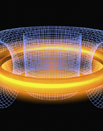 Antonio Della Corte - Simonetta Turtù Antonio Della Corte - Simonetta Turtù
PROCESS AND TECHNOLOGY STATUS – Superconductivity is the ability of certain metals, alloys and ceramic materials to
let electrical current flow with no electrical resistance and energy dissipation. Superconductivity appears at below a certain
(critical) temperature, which is between 30K and 120K (-243°C and -153°C) for high-temperature superconductors (HTS) and
below 20K (-253°C) for the low-temperature superconductors (LTS). Superconducting properties disappear if the temperature
rises above the critical value, but also in the presence of high current density or strong external magnetic fields. The critical
values of temperature, magnetic field and current density are specific characteristics of each superconductor material. Almost
all of today’s superconductors are based on Nb (niobium) and Nb-alloys LTS wires, which have already reached a high level of
industrialization. LTS use is common practice in the production of small superconducting magnets for medical diagnostics
(magnetic resonance imaging, MRI), in research applications, and in large superconducting magnets for world-scale
experimental facilities (nuclear fusion, particle accelerators and detectors for high-energy physics). At present, LTS represent a
commercially available technology while ceramic HTS are still under development. HTS research has been recently boosted by
new discoveries and focuses on the complex ceramic HTS materials and their production process. Advanced cryogenics plays
a key technical and economic role in superconductivity, and may drive important developments.
|
|
Read more...
|
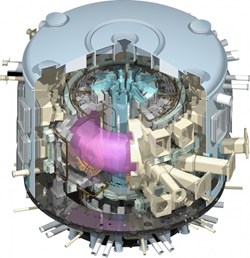 ITER is a large-scale scientific experiment that aims to demonstrate that it is possible to produce commercial energy from fusion. The Q in the formula on the right symbolizes the ratio of fusion power to input power. Q ≥ 10 represents the scientific goal of the ITER project: to deliver ten times the power it consumes. From 50 MW of input power, the ITER machine is designed to produce 500 MW of fusion power - the first of all fusion experiments to produce net energy. During its operational lifetime, ITER will test key technologies necessary for the next step: the demonstration fusion power plant that will prove that it is possible to capture fusion energy for commercial use. ITER is a large-scale scientific experiment that aims to demonstrate that it is possible to produce commercial energy from fusion. The Q in the formula on the right symbolizes the ratio of fusion power to input power. Q ≥ 10 represents the scientific goal of the ITER project: to deliver ten times the power it consumes. From 50 MW of input power, the ITER machine is designed to produce 500 MW of fusion power - the first of all fusion experiments to produce net energy. During its operational lifetime, ITER will test key technologies necessary for the next step: the demonstration fusion power plant that will prove that it is possible to capture fusion energy for commercial use.
The science going on at ITER - and all around the world in support of ITER - will benefit all of mankind.
To understand the ITER project in its myriad technical, scientific, and organizational details is not an easy task. Nevertheless, it is one of our key goals to make the project as accessible and understandable as possible, by providing a wide range of information, and introducing you to some of the people who have come from all over the world to build ITER.
|
|
Read more...
|
|
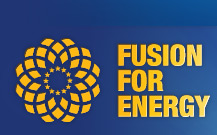
The greatest increase in demand for energy is envisaged to come from developing countries where, with rapid urbanisation, large-scale electricity generation will be required. With environmental requirements for zero or low CO2 emission sources and the need to invest in a sustainable energy mix, new energy sources must be developed. Fusion will be available as a future energy option by the middle of this century, and should be able to acquire a significant role in providing a sustainable, secure and safe solution to tackle European and global energy needs.
Fusion is the process which powers the sun and the stars. It is energy that makes all life on earth possible. It is called 'fusion' because the energy is produced by fusing together light atoms, such as hydrogen, at the extremely high pressures and temperatures which exist at the centre of the sun (15 million ºC). At the high temperatures experienced in the sun any gas becomes plasma, the fourth state of matter (solid, liquid and gas being the other three).
|
|
Read more...
|
|
|
|
|
|
|